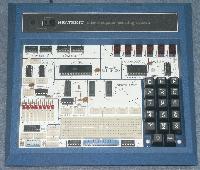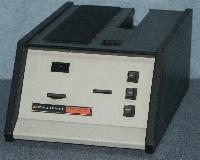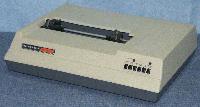 The Heathkit ET-3400.
The Heathkit ET-3400.Views: Side, Bottom, Inside.
The Heath company produced "build it yourself" kits for everything from Radios to Robots. Here are some of their computer offerings.
Click any photo to view a large high-resolution image.
The ET-3400 is the "little Heathkit computer", an educational trainer from 1977. It is based on the 6800 CPU, came with a whopping 256 bytes of RAM (expandable to 512 bytes) and a 1K on-board ROM monitor program.
 The Heathkit ET-3400.
The Heathkit ET-3400.
Views:
Side,
Bottom,
Inside.
 The ET3400 is one in a series of educational trainers. Here are the ET-3100
Analog and ET-3200 Digital logic trainers.
The ET3400 is one in a series of educational trainers. Here are the ET-3100
Analog and ET-3200 Digital logic trainers.
The Heathkit H8 is a popular kit computer from 1977. It is based on the Intel 8080 CPU, and features a "soft" front panel which is implemented via a ROM based monitor program.
The H8 was donated by Rob Krten.
Views: Back, Inside-front, Inside-back,
 The Heath documentation binder.
The Heath documentation binder.
Operation and Assembly manuals.
Serial/Cassette and 4K memory manuals.
In 1979 Heathkit prodiced the H89 - an all-in-one Z80 based unit which could run Heath's own HDOS or the industry standard CP/M operating system.
 The Heathkit H89. Most H89s have an internal diskette drive, and a label that
reads "H89" - I believe this unit may be an upgrated H88 or possibly an upgraded
H19 terminal. The H19 was based on the same chassis and
video controller board, and Heath offered the H89
boards an an upgrade. Shown to the left is an H77 dual-drive system.
The Heathkit H89. Most H89s have an internal diskette drive, and a label that
reads "H89" - I believe this unit may be an upgrated H88 or possibly an upgraded
H19 terminal. The H19 was based on the same chassis and
video controller board, and Heath offered the H89
boards an an upgrade. Shown to the left is an H77 dual-drive system.
H89 Views:
Back, Open:
Card "cage" behind monitor,
Top,
Left-side,
Right-side,
Back.
H77 Views:
Back, Open:
Left-side,
Right-side.
 This is the H10 paper tape reader/punch. Paper tape was a common way
of storing programs in the early days of personal computing.
This is the H10 paper tape reader/punch. Paper tape was a common way
of storing programs in the early days of personal computing.
Operation Manual (550k PDF)
Operation illustration booklet (1.2M PDF)
Assembly manual (13M PDF)
Assembly illustation booklet (4.5M PDF)
Schematic (630k PDF)
 The H14 printer is another common companion to an H8 system. Like all Heathkit
products, you assembled it yourself.
The H14 printer is another common companion to an H8 system. Like all Heathkit
products, you assembled it yourself.
Operaton manual (7.3M PDF)
Assembly manual (14M PDF)
Illustration booklet (4.4M PDF)
Schematic (475k PDF)